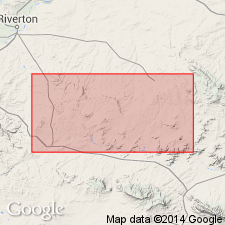
- Usage in publication:
-
- Big Sand Draw Sandstone Lentil*
- Modifications:
-
- Named
- Dominant lithology:
-
- Sandstone
- Mudstone
- AAPG geologic province:
-
- Wind River basin
Summary:
Big Sand Draw Sandstone Lentil of White River Formation. Called Sand Draw Sandstone Lentil in earlier reports. Is a well-bedded, yellowish-gray, biotite-rich, volcanic mudstone and sandstone in the lowest 15 feet of the White River. Is silicified in the basal 1 to 3 feet. Upper part is a soft calcareous greenish-yellow to yellowish-gray volcanic arkose containing lenses and layers of pebble conglomerate, generally less than 1 foot thick. Most of the pebbles are well-rounded quartz and light-gray Precambrian igneous and metamorphic rock. Some of the pebbles are dark-gray and reddish-brown Tertiary volcanic rock. Has a maximum thickness of 77 to 80 feet. Overlies Wagon Bed Formation (new); grades upward into Beaver Divide Conglomerate Member. Correlates with part of Wiggins Formation. Crops out along Beaver Rim, in T. 30 through 32 N., R. 94 through 96 W. Fossil mammals of early Oligocene or early Chadronian age identified.
Type section is north of Wagon Bed Spring in sec. 25, T. 32 N., R. 95 W., south-central Fremont Co., west-central WY (Wind River basin). Named from exposures south of Big Sand Draw anticline, in SE/4 sec. 25, T. 32 N., R. 95 W., south-central Fremont Co., west-central WY.
Source: Modified from GNU records (USGS DDS-6; Denver GNULEX).
For more information, please contact Nancy Stamm, Geologic Names Committee Secretary.
Asterisk (*) indicates published by U.S. Geological Survey authors.
"No current usage" (†) implies that a name has been abandoned or has fallen into disuse. Former usage and, if known, replacement name given in parentheses ( ).
Slash (/) indicates name conflicts with nomenclatural guidelines (CSN, 1933; ACSN, 1961, 1970; NACSN, 1983, 2005, 2021). May be explained within brackets ([ ]).

